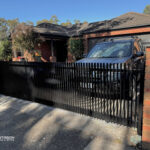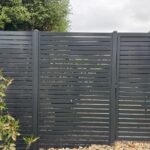Fencing is an integral part of property management, providing privacy, security, and aesthetic appeal. While traditional wood fences offer a classic look, they often lack the durability of other materials. This is where combining wood with metal posts comes into play. Building a wood fence with metal posts marries the beauty of wood with the strength of metal, resulting in a fence that is both visually appealing and long-lasting. This guide will walk you through everything you need to know about constructing a wood fence with metal posts, from planning and material selection to installation and maintenance.
Why Choose Metal Posts for a Wood Fence?

Before diving into the construction process, it’s essential to understand why metal posts are an excellent choice for wood fences.
- Durability and Strength: Metal posts, typically made from galvanized steel or aluminum, offer superior strength and durability compared to wooden posts. They resist rot, insect damage, and warping, which are common issues with wood. This ensures that your fence remains sturdy and stable for many years.
- Resistance to Weather: Metal posts are less susceptible to weather-related damage. Whether it’s extreme heat, cold, or moisture, metal posts maintain their integrity, unlike wood, which can crack, split, or decay over time.
- Aesthetic Flexibility: Metal posts can be hidden within the fence structure or painted to match the wood, allowing you to maintain the natural, warm appearance of a wooden fence without compromising on durability.
- Cost-Effectiveness: Although metal posts are more expensive upfront, their longevity and lower maintenance requirements make them cost-effective in the long run. You won’t need to replace them as often as wooden posts, saving you time and money.
Planning Your Wood Fence with Metal Posts
Proper planning is crucial to ensure that your fence meets your needs and stands the test of time.
- Determine Your Fence’s Purpose: Are you building the fence for privacy, security, decoration, or to keep pets or children within a designated area? Understanding the primary purpose will help you decide on the height, style, and placement of the fence.
- Check Local Regulations: Before you start building, check with your local government or homeowners’ association to ensure that your fence complies with zoning laws and regulations. There may be restrictions on height, materials, and placement.
- Measure Your Property: Accurate measurements of your property line are essential to avoid disputes with neighbors. Use a measuring tape or a wheel measure to determine the length of the fence and the spacing of the posts.
- Choose Your Materials: Select the type of wood you want for the fence panels and pick the right metal posts. Common wood options include cedar, pine, and redwood, while metal posts are usually made from galvanized steel or aluminum.
- Design Your Fence: Decide on the design of your fence. Do you want a simple picket fence, a solid privacy fence, or something more decorative? The design will influence the construction process and the materials you need.
Materials and Tools Required
Once you have a plan in place, gather the necessary materials and tools for the job.
Materials:
- Metal posts (galvanized steel or aluminum)
- Wood panels or pickets
- Concrete mix (for setting posts)
- Post caps (to protect metal posts from moisture)
- Screws or brackets (for attaching wood to metal)
- Wood sealant or paint (optional)
Tools:
- Post hole digger or auger
- Level
- Measuring tape
- Saw (for cutting wood)
- Power drill
- Screwdriver
- Shovel
- Wheelbarrow (for mixing concrete)
- Protective gear (gloves, safety glasses)
Step-by-Step Installation Guide

Now that you’ve gathered your materials and tools, it’s time to start building.
Step 1: Mark the Fence Line
Use stakes and string to mark the fence line on your property. This will guide the placement of your posts and ensure that your fence is straight.
Step 2: Dig Post Holes
Using a post hole digger or auger, dig holes for your metal posts along the marked fence line. The depth of the holes should be one-third of the total post length (e.g., a 6-foot post should be buried 2 feet deep) to ensure stability.
Step 3: Set the Metal Posts
Place a metal post in each hole, ensuring that it is level. Pour concrete mix into the hole around the post, filling it to just above ground level. Use a level to double-check that the post is straight, then allow the concrete to cure for at least 24 hours.
Step 4: Attach the Wood Panels
Once the posts are securely in place, it’s time to attach the wood panels or pickets. There are two common methods for this:
- Brackets: Attach metal brackets to the posts using screws, then secure the wood panels to the brackets.
- Direct Attachment: Drill holes through the wood panels and metal posts, then use screws to attach the panels directly to the posts.
Ensure that the panels are level and evenly spaced.
Step 5: Install Post Caps
To protect the metal posts from moisture and prolong their lifespan, install post caps on top of each post. This is especially important in regions with high rainfall or humidity.
Step 6: Apply Finishing Touches
If you want to enhance the appearance of your fence, consider staining or painting the wood. Applying a sealant can also protect the wood from moisture, UV rays, and insects, extending the life of your fence.
Read more: Discover 6 Stylish Wood Fence Idea for Your Home
Maintenance Tips for Your Wood Fence with Metal Posts
Even though metal posts require minimal maintenance, the wood panels will need some care to keep your fence looking its best.
- Regular Inspections: Periodically inspect your fence for signs of damage or wear, such as loose panels, cracked wood, or rust on the metal posts. Address any issues promptly to prevent further damage.
- Cleaning: Clean the wood panels regularly to remove dirt, mildew, and stains. A simple solution of water and mild detergent, applied with a soft brush, will do the trick. Avoid using a pressure washer, as it can damage the wood.
- Repainting or Restaining: Depending on the climate and exposure to the elements, you may need to repaint or restain your fence every 2-3 years. This will protect the wood and keep it looking fresh.
- Protect Against Pests: Treat the wood with an insect repellent or sealant to protect against termites and other wood-boring pests. If you notice any signs of infestation, take immediate action to prevent the pests from spreading.
- Monitor for Rust: Although galvanized steel and aluminum are resistant to rust, it’s still a good idea to check the metal posts periodically. If you notice any rust spots, sand them down and apply a rust-resistant paint to prevent further corrosion.
Cost Considerations
The cost of building a wood fence with metal posts can vary widely depending on the materials used, the size of the fence, and whether you choose to hire professionals or do it yourself.
- Material Costs: Metal posts are generally more expensive than wooden posts, but they offset this cost with their durability. Wood prices vary based on the type of wood, with cedar and redwood being more expensive than pine.
- Labor Costs: If you choose to hire a contractor, labor costs will add to the overall expense. However, hiring professionals can save time and ensure a high-quality installation.
- Maintenance Costs: Over time, maintenance costs for a wood fence with metal posts will be lower than for a traditional wood fence due to the reduced need for post replacements.
- Long-Term Value: While the initial investment may be higher, the long-term value of a wood fence with metal posts is significant. The fence will last longer, require fewer repairs, and maintain its appearance better than a wood-only fence.
Environmental Considerations
When building a fence, it’s important to consider the environmental impact of the materials you choose.
- Sustainable Wood: Opt for wood that is sustainably sourced, such as FSC-certified lumber. This ensures that the wood comes from responsibly managed forests.
- Recyclable Metal: Metal posts are recyclable, making them an environmentally friendly choice. At the end of their lifespan, the posts can be recycled and repurposed.
- Eco-Friendly Finishes: If you choose to paint or stain your fence, look for eco-friendly products that are low in volatile organic compounds (VOCs). These finishes are better for the environment and your health.
Conclusion
Building a wood fence with metal posts is an excellent way to combine the natural beauty of wood with the strength and durability of metal. This hybrid fence design offers the best of both worlds, providing long-lasting performance and a timeless appearance. With proper planning, material selection, and maintenance, your fence will stand strong and look great for many years to come.
Whether you’re a DIY enthusiast or prefer to hire a professional, this guide provides the essential steps and considerations to ensure a successful fence installation. By choosing the right materials and taking the time to do the job correctly, you’ll create a fence that not only meets your needs but also adds value and curb appeal to your property.




